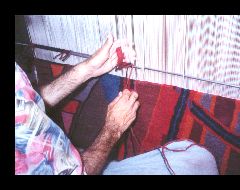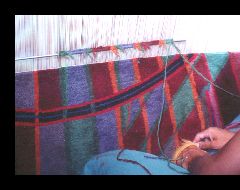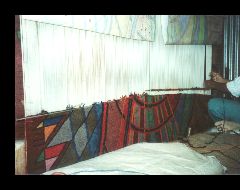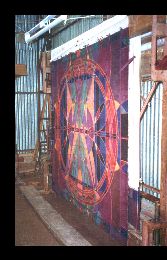



Rug Handknotting features, qualities and techniques
| FEATURES | |
 Custom design
Custom design100% Tibetan wool 600 colors in addition to custom colors Any size available up to 18 feet in width and 28 feet in length. Actual sizes may vary slightly from the design because of the hand-made process. Round, oval and other shapes are also available. 100% Hand-made Including wool washing, carding, dyeing, knotting, trimming and washing. Custom pile height (3/8", 7/16" and 9/16") available as designated by the owner/designer. All heights are approximate and can vary slightly. |
|
| QUALITIES | |
| FOUNDATION | |
 Highest quality "machine cotton industrial thread" is used for the foundation
Highest quality "machine cotton industrial thread" is used for the foundationSingle weft (transverse) thread is used in the foundation 100 knots/sq.inch - 10 warp threads/inch and 10 weft threads/inch. Knots per square inch can vary slightly because of the handknotting process. Typical range is 95-100 knots/sq.inch. |
|
| YARN | |
 100% Tibetan highland sheep's wool is used in the pile (knot)
100% Tibetan highland sheep's wool is used in the pile (knot)Tibetan wool is characteristically flexible, strong, lustrous and springy. It is not similar to any other wool of any other place in the world. Because of the sheep's existence at colder, harsher highland regions, the wool has a unique desirable coarseness and thickness combined with very long fibers (5-8 inch staple.) The wool is highly durable due to its high hair content and the capillary tubes in the hair or fiber. The silky appearance of the inner hairs along with the wool's other qualities develops a wonderful patina. The resulting carpet can last for a century through normal use. 3 ply wool yarn is used for pile, resulting in denser, springy carpets Some Nepalese carpet industries use only 2 ply wool, some use 3 ply wool made up of two different kinds of wool i.e. one ply of Tibetan wool and two ply of New Zealand. Switzerland's high quality bio-product color fast dyes Open pot dyed yarn Most Nepalese carpet industries use pressure/mist cabinet dyed yarns that require holding the yarn at high temperatures for two hours or longer. Pot dyeing holds the yarn at high temperatures for 45 minutes. Prolonged duration at high temperature destroys some of the desired natural characteristics of the wool. No scrap wool carpet trimmings of pile are used in the yarn Some industries save pieces of yarn and trimmings of pile and reincorporate them back into yarn, resulting in much shorter fibers in the yarn and significantly reduced strength and quality. Hand-spun wool yarn A carpet made with hand-spun wool has slight abrasions and the colors are not exact and sharp, resulting in a typical hand-made village look. Hand-spun yarn tends to unwind at the tips and give the finished pile a thick, flossy appearance. An overall soft and harmonious impression emerges and also a soft, "springy" feel. Nepalese carpet industries typically use machine carded and machine-spun yarns, losing the hand-spun village look and also reducing the "springy" effect. |
|
| TECHNIQUES | |
 Proper pounding of each row of knots with the mallet and comb beater. This ensures dense, fully compacted pile.
Proper pounding of each row of knots with the mallet and comb beater. This ensures dense, fully compacted pile.After weaving, the carpet is soaked and washed in a chemical solution. One can have normal wash or an acid wash (to make it look antique). Washed and dried carpets are given a final flat trimming. The trimming is of the pile face for final finishing. Sculpturing of the design is also done at this time, if desired. Exposed fringe or covered fringe. Normally, the end (warp) fringe is left exposed but upon request, the fringe can be turned underneath. The fringe turned underneath is then finished and covered with selected color cotton cloth. |
|
Copyright © 2001-2017 Daryl Hansen Architect